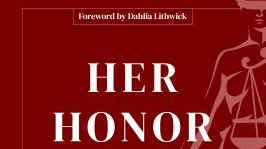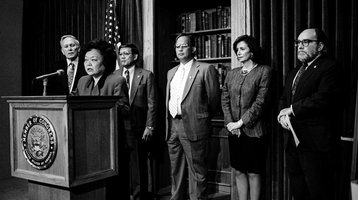Lorraine Hansberry: Her Chicago law story
What happens to a dream deferred?
Does it dry up like a raisin in the sun…
Or does it explode? —Langston Hughes
Lorraine Vivian Hansberry was born in Chicago on May 19, 1930, the youngest of four children born to Carl Augustus Hansberry, a prominent real estate broker, and his wife, Nannie Louise Hansberry, a schoolteacher and ward committeewoman. Lorraine’s uncle, William Leo Hansberry, taught African history at Howard University. On May 26, 1937, Carl Hansberry moved the family to Woodlawn (map), an all-white neighborhood near the University of Chicago. The Hansberry family home (6140 S. Rhodes Ave.) was declared an historic landmark by the Chicago City Council on February 10, 2010.
Anna M. Lee and others brought an action in the Circuit Court of Cook County to enforce a restrictive covenant, and enjoin the Hansberrys from occupying their home. Under the “restrictive agreement”, about 500 Chicago property owners agreed that no part of the real estate should be “sold, leased to, or permitted to be occupied by any person of the colored race”. The restrictive covenant covered blocks between 60th and 63d streets, and between Cottage Grove and South Park avenues [now Martin Luther King Drive] in Chicago. The trial court held that Burke v. Kleiman (1934), in which the parties stipulated to the validity of the covenant, bound Mr. Hansberry even though he was not a party to that litigation. In Lee v. Hansberry (1939), the Supreme Court of Illinois affirmed the trial court’s judgment.
Ms. Hansberry’s father and mother, represented by Earl B. Dickerson, J.D. `20 and several other members of an NAACP litigation team, appealed the decision to the U.S. Supreme Court. In Hansberry v. Lee, 311 U.S. 32 (1940), Justice Stone, writing for the majority, reversed the Illinois Supreme Court decision on the basis that neither party to the Burke litigation represented Mr. Hansberry’s interests. Works on class action and civil procedure often cite the Hansberry case for the fundamental due process principle that “a ruling cannot bind absent class members if the representatives are inadequate.” (Klonoff, at 57). Despite the Supreme Court victory, Lorraine Hansberry believed her father never recovered from his struggle against racial segregation. Mr. Hansberry passed away from a cerebral hemorrhage on March 7, 1946, at the age of 50, while visiting Mexico. He’d planned to move the family there.
Lorraine Hansberry attended kindergarten on Chicago’s South Side. “The kids beat me up; and I think it was from that moment I became a rebel.” When Lorraine was 8, a “howling” mob attacked her family’s home. A brick hurled through the window narrowly missed Lorraine’s head. As a child, Lorraine met Paul Robeson, Langston Hughes, W.E.B. Du Bois, and other civil rights activists who frequently visited her family. Lorraine went to Betsy Ross Elementary School and graduated from Englewood High School in 1948. Lorraine was politically active and worked for social justice throughout her brief adult life. She was an associate editor for Paul Robeson’s progressive Freedom newspaper. She participated in the civil rights movement in the South as a field organizer for CORE (the Congress of Racial Equality). She supported the fledgling American lesbian liberation movement. Lorraine Hansberry died of pancreatic cancer on January 12, 1965 at the age of 34. But Ms. Hansberry’s story is not over. It continues in her writings:
“I think, then, that Negroes must concern themselves with every single means of struggle: legal, illegal, passive, active, violent and non-violent. That they must harass, debate, petition, give money to court struggles, sit-in, lie-down, strike, boycott, sing hymns, pray on steps, and shoot from their windows when the racists come cruising through their communities. The acceptance of our present condition is the only form of extremism which discredits us before our children.” (To Be Young, Gifted and Black, at 214).
Below are resources for researching Ms. Hansberry’s Chicago law story:
Cases
Lee v. Hansberry, 372 Ill. 369, 24 N.E. 2d 37 (Ill., 1939).
Hansberry et al. v. Lee et al., 311 U.S. 32 (1940)(via HeinOnline U.S. Supreme Court Library).
Briefs (via Gale/Cengage U.S. Supreme Court Briefs). Attorneys for Petitioners: Earl B. Dickerson, Truman K. Gibson, Jr., C. Francis Stradford, Loring B. Moore, and Irvin C. Mollison. Attorneys for Respondents: Angus Roy Shannon, McKenzie Shannon, William C. Graves, Preston B. Kavanagh, and Randolph Thornton.
Books, Articles, & Videos
Carter, Steven R. Hansberry’s Drama: Commitment and Complexity (Urbana: University of Illinois Press, 1991). Regenstein Bookstacks, PS3515.A595Z8C25 1991.
Cheney, Anne. Lorraine Hansberry (Boston: Twayne, 1984). Regenstein Bookstacks, PS3515.A595Z8C51.
Domina, Lynn. Understanding A Raisin in the Sun: A Student Casebook to Issues, Sources, and Historical Documents (Westport, Conn.: Greenwood, 1998).
The Electronic Encyclopedia of Chicago (Chicago Historical Society, 2005; Chicago History Museum, Newberry Library, and Northwestern University; Janice L. Reiff, Anne Durkin Keating, and James R. Grossman eds.).
Entries for: “Washington Park Subdivision”, “Restritive Covenants”, “National Association for the Advancement of Colored People (NAACP)”, “Open Housing”.
Graettinger, Robert. “A Raisin in the Sun As Commentary on Hansberry v. Lee,” 17 CBA Record, June-July 2003, at 30.
Hansberry, Lorraine. A Raisin in the Sun: A Drama in Three Acts (New York: Random House, 1959). Regenstein Bookstacks, PS3515.A595R3 1959.
Kamp, Allen R. (J.D. ’69) “The History Behind Hansberry v. Lee,” 20 U.C. Davis Law Review 481-499 (1987).
Keppel, Ben. The Work of Democracy: Ralph Bunche, Kenneth B. Clark, Lorraine Hansberry, and the Politics of Race (Cambridge, Mass.: Harvard University Press, 1995). Regenstein Bookstacks, E185.61.K390 1995.
Includes chapters on “The Political Education of Lorraine Hansberry” and “The Dialectical Imagination of Lorraine Hansberry”.
Long, Herman H. & Charles S. Johnson. People vs. Property: Race Restrictive Covenants in Housing (Nashville: Fisk University Press, 1947). D’Angelo Law, North Annex, KB3188.L38P4 1947.
“Lorraine Hansberry,” Gay & Lesbian Biography 216-218 (Michael J. Tyrkus ed., Detroit: St. James Press, 1997). Regenstein, General Reference, HQ75.2.G39 1996.
McKissack, Patricia C. & Fredrick McKissack. Young, Black, and Determined: A Biography of Lorraine Hansberry (Holiday House, 1997).
Metzger, Linda (ed.). “Lorraine Hansberry,” Black Writers 146-147 (Detroit: Gale Research, 1989). 2d ed.: Regenstein Bookstacks, E185.96.B545 1994.
A Raisin in the Sun (1961). D’Angelo Law Reserve Room, DVD PN1997.Z9R36 1999.
“Film of the award-winning play about a struggling black family living on Chicago’s South Side and the impact of an unexpected insurance bequest. Each family member sees the bequest as the means of realizing dreams and of escape from grinding frustrations.” Starring Sidney Poitier, Claudia McNeil, Ruby Dee. Produced by David Susskind & Philip Rose. Directed by Daniel Petrie. Screenplay by Lorraine Hansberry.
Sharadha, Y. S. Black Women’s Writing: Quest for Identity in the Plays of Lorraine Hansberry and Ntozake Shange (New Delhi: Prestige Books, 1998). Regenstein Bookstacks, PS3515.A515Z86 1998.
To Be Young, Gifted and Black: Lorraine Hansberry in Her Own Words (Englewood Cliffs, NJ: Prentice-Hall, 1969). Regenstein Bookstacks, PS3515.A595Z8N4.
Adapted by Robert Nemiroff. With original drawings and art by Miss Hansberry. And an introduction by James Baldwin.
To Be Young, Gifted and Black (PBS TV, 1972). 1998 VHS video available via Amazon.
“Use of Class Actions in Restrictive Covenant Cases,” 7 University of Chicago Law Review 563-567 (1940). About Lee v. Hansberry, 24 N.E.2d 37 (Ill., 1939).
Vose, Clement E. Caucasians Only: The Supreme Court, the NAACP, and the Restrictive Covenant Cases (Berkeley: University of California Press, 1959). D’Angelo Law, North Annex, KB6247.V6C3 1959 c.1a.
Wilkerson, Margaret B. “Hansberry, Lorraine Vivian (1930-1965),” 1 Black Women in America: A Historical Encyclopedia 524-529. (Darlene Clark Hine ed., Brooklyn, NY: Carlson Publishing, 1993). Online via the Black Women Writers: African, African American, and Diaspora database.





